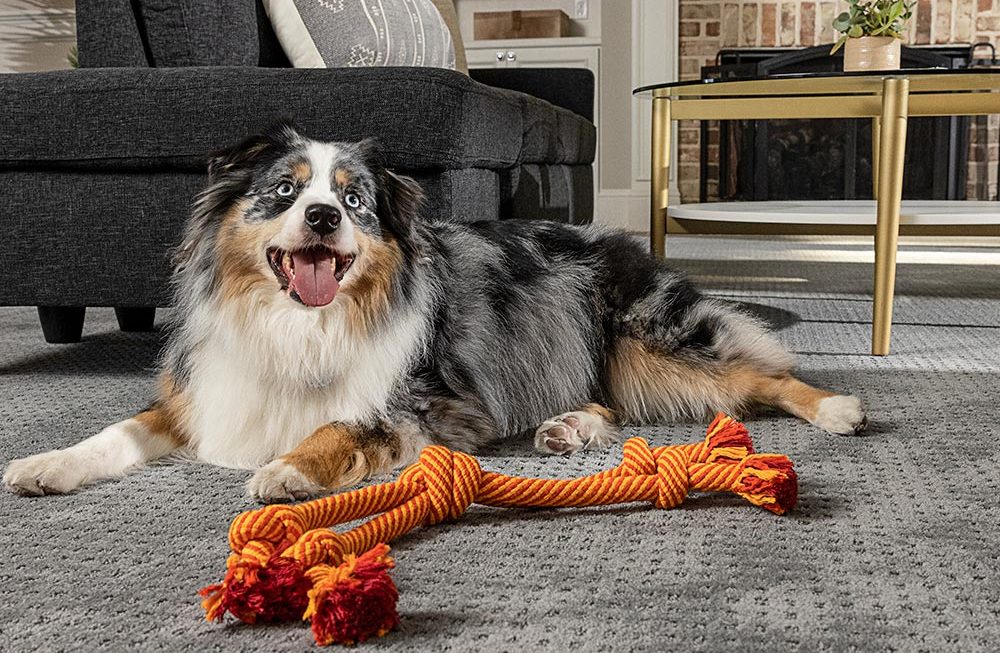The Mystery Behind Our Dogs’ Carpet Scratching
Unraveling the mystery of why dogs scratch carpets can be quite the puzzle. While it may seem like a random act, there’s actually a range of reasons that can drive this behavior. From boredom to instinct, each dog may have a unique motivation. Understanding these reasons is crucial in finding the right solution. By exploring the common causes, we can develop effective strategies to redirect this habit into more appropriate activities. Addressing carpet scratching not only protects your home but also ensures the well-being of your furry friend.
The Role of Instincts in Canine Digging and Scratching Behavior
Every dog has instincts that can explain their carpet scratching. It’s part of their DNA. Ancestors like wolves used digging for several reasons. They made dens, hid food, and hunted underground. These actions are not needed for survival today. Yet, domestic dogs still feel the urge. Carpets can seem like a good place to dig. It imitates the action they’re programmed to do.
In the past, dogs scratched to build comfortable sleeping areas. They also did it to find food or hide treasures. Though today’s dogs have their needs met, instincts remain strong. Recognizing the natural digging and scratching instinct can help. It can guide us in providing suitable outlets for this behavior.
By doing so, we make sure our pets are happy. Also save our carpets from harm. We can offer them toys that simulate digging. We can also spend more time playing with them. Both will use up the energy they might otherwise spend on the carpet.
In conclusion, instincts play a big role in why dogs scratch carpets. Understanding them is key to addressing the behavior effectively. And by doing so, we keep our furry friends engaged and our carpets intact.
Factors Influencing Carpet Scratching: Boredom and Activity Needs
Understanding why dogs scratch carpets often boils down to their activity needs. If a dog lacks physical exercise or mental stimulation, it may turn to scratching. This is because scratching can be a way to relieve boredom. It can also be a self-created task to keep them busy. Active breeds in particular have high energy levels. If not met, these breeds might find carpets an easy target for an activity.
Keeping your dog engaged is crucial. It could be simple, like more walks or game time. Mental stimulation is important too. Puzzle toys and new tricks can keep a dog’s mind active.
Another point to consider is the quality of playtime. Dogs need varied activities to stay interested. They enjoy not just the exercise itself, but also interacting with their owners. It brings them joy and wears them out.
Long-lasting chew toys can work wonders. They help manage boredom and reduce the urge to scratch.
In short, a good balance of physical and mental activities can prevent carpet scratching. It keeps dogs from seeking out carpets to use excess energy. Happy dogs with enough to do at home rarely damage carpets.

Anxiety and Stress-Induced Scratching in Dogs
Dogs often scratch the carpet due to stress or anxiety. This behavior acts as an escape mechanism or stress relief. For instance, loud noises like thunder may frighten them, triggering the instinct to dig. Carpet scratching can be their way of coping. To reduce this, create a calm space. Use things like pheromone diffusers. Offer comforting toys or a safe retreat. Consistent training helps too. Teach your dog to calm down or focus elsewhere. Above all, understand that patience is key. Work together to help your dog feel secure, reducing the need to scratch.
Understanding Territorial Marking Through Scratching
Dogs use scratching as a way to mark their territory. This behavior stems from their ancestral roots. Wild canines would leave scent marks in their area to communicate with others. Domestic dogs carry this instinct, though they no more live in the wild.
When your dog scratches the carpet, it leaves behind a scent. This scent comes from glands in their paws. It tells other dogs, “This is my space!” It’s a natural behavior, often seen in homes with more than one pet.
To address this, provide your dog with their own items to mark. Give them blankets or beds that are okay to scratch. This redirects the behavior to a suitable place. Also, regular cleaning can help. It removes existing scents and deters further marking.
Consistent training can prevent inappropriate scratching. Teach your dog where it’s okay to scratch and where it’s not. Use positive reinforcement to encourage good behavior. Reward them when they mark the correct items or areas.
In summary, scratching is a way for dogs to communicate dominance or claim area. Understanding this helps us provide better outlets for their territorial urges. This leads to a happier home for both dogs and owners.
Long Nails and Discomfort: Physical Causes of Scratching
Scratching can signal discomfort in dogs. Long nails might cause this behavior. When nails grow too long, they can press into the soft tissue. This causes pain. Dogs may scratch carpets to file down their nails. They seek relief. Keep your dog’s nails trimmed to prevent discomfort. Check their nails regularly. Ensure they are not too long or sharp.
Paws can also cause discomfort. Mud, thorns, or gum may stick to them. Your dog may try to remove irritating substances by scratching. Regularly check their paws for foreign objects. Clean them gently if they look dirty or sore.
Dog beds can cause discomfort too. Some dogs scratch at carpets for a softer place to rest. Consider if your dog’s bed is comfortable enough. A cozy bed may prevent scratching for comfort.
Discomfort from joint pain or skin issues can also lead to scratching. Dogs with arthritis may try to make a soft space to ease pain. If you notice more scratching, your dog might be in pain. Consult a vet to rule out health issues. Addressing physical discomfort can stop carpet scratching. It leads to a happier and healthier dog.

Addressing the Behavior: Training and Redirection
To manage your dog’s carpet scratching, consider training and redirection. Start with basic commands like ‘sit’ and ‘leave it’. These teach your dog what behaviors are acceptable. When your dog begins to scratch, use these commands to redirect their attention. Reward good behavior with treats or affection. This reinforces the behavior you want to see.
For redirection, provide alternatives like a scratch mat or toys. These should be more enticing than the carpet. Choose toys that engage your dog’s natural instincts. Puzzle toys work well to keep their mind busy. Tug toys and chew treats can help manage their need to dig. Always supervise your dog’s playtime. Make sure they’re safe and enjoying themselves.
Remember, dogs learn through consistency. So, keep the training regular and the rules clear. Avoid punishments for wrong behaviors. Instead, focus on guiding them towards the right ones. Over time, this approach helps break your dog’s carpet scratching habit. With patience and understanding, you can redirect their behavior.
Common Solutions to Discourage Carpet Scratching
Addressing your dog’s carpet scratching behavior may seem challenging, but it’s manageable with the right approach. Common solutions that can help discourage this behavior include:
- Provide Adequate Exercise: Ensure your dog gets plenty of exercise. Active dogs are less likely to seek out carpets for relief.
- Engage Their Minds: Offer puzzle toys and training sessions that challenge their intelligence.
- Create a Designated Digging Area: Set up a specific spot for your dog to dig, reinforcing it as the appropriate place.
- Regular Nail Trims: Keep your dog’s nails trimmed to avoid discomfort that leads to scratching.
- Comfortable Resting Spots: Provide cushy beds or areas where your dog can rest without resorting to the carpet.
- Positive Reinforcement: When your dog chooses toys over carpets, offer praise and treats.
- Address Anxiety: For dogs scratching due to stress, consider creating a calming environment with pheromone diffusers or special anxiety toys.
- Territorial Solutions: Provide your dog with blankets or beds they can mark, satisfying their urge to claim an area.
By implementing these strategies, you can help steer your dog away from scratching the carpets and towards more suitable activities. Always remember to be patient and consistent with your approach for the best results.
The Importance of Providing Proper Toys and Alternatives
Offering the right toys and alternatives is vital in curbing your dog’s carpet scratching. Dogs often turn to carpets when they lack other outlets for their natural behaviors. Ensure your dogs have engaging toys that meet their play and instinctive needs. This can greatly reduce unwanted scratching on carpets.
Toys come in many forms and function to keep your dog entertained. Here are a few types:
- Puzzle toys: These challenge your dog’s mind and reduce boredom.
- Chew toys: Durable options satisfy the need to chew and help maintain healthy teeth.
- Tug toys: These are great for interactive play and can strengthen your bond.
- Squeaky toys: They excite dogs and can keep them busy for hours.
Creating a digging box is another great alternative. Fill it with sand or soft soil, where your dog can dig freely. Hide treats or toys in it for extra motivation and fun.
Also, remember that playtime with you is irreplaceable. Spend quality time with your dog each day. Play fetch, tug-of-war, or just enjoy a walk together. Your attention will not only discourage carpet scratching but will also strengthen your relationship.
Finally, regular exercise should not be overlooked. A tired dog is less likely to scratch up carpets. Adequate daily walks and play sessions are essential.
By providing proper toys and alternatives, you reduce the risk of carpet scratching. Your dog stays happy and active, and your carpets remain intact. It’s a win-win situation.

Expert Advice: When to Seek Professional Help
Sometimes, despite our best efforts, a dog’s carpet-scratching habit persists. It might be due to reasons that are not easily identifiable or solvable by general advice. In such cases, seeking professional help could be the most effective solution.
Here are signs indicating it’s time to consult a professional:
- Persistent Behavior: If your dog continues to scratch the carpet aggressively despite trying all the suggested solutions.
- Signs of Anxiety: If carpet scratching seems to be linked with other signs of anxiety like pacing, panting, or hiding.
- Health Concerns: The scratching is accompanied by other physical symptoms that might indicate a health issue, such as limping, excessive licking, or discomfort.
- Behavioral Changes: If you notice sudden and radical changes in your dog’s behavior that you can’t explain.
Professionals such as veterinarians, animal behaviorists, or professional dog trainers have the relevant expertise to diagnose the underlying issues. They can provide tailored strategies to address your dog’s specific needs. They might suggest changes to the home environment, recommend different training techniques, or in some cases, prescribe medication.
Don’t hesitate to seek help if it’s needed. Professional guidance can prevent the situation from worsening and ensure the health and happiness of your dog.
Finally, it’s essential to maintain a comfortable and stimulating home environment for your pet. Toys, playtime, regular check-ups, and love can all contribute to a healthy lifestyle, minimizing problem behaviors like carpet scratching.



